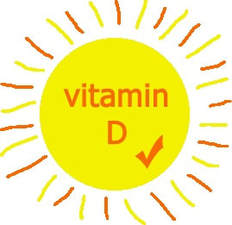High vitamin D levels linked to lower cholesterol in children
There is a link between higher serum vitamin D levels and lower plasma cholesterol levels in primary school children, new research shows.

There is a link between higher serum vitamin D levels and lower plasma cholesterol levels in primary school children, new research from the University of Eastern Finland shows. Children whose serum 25-hydroxyvitamin D levels exceeded 80 nmol/l had lower plasma total and low-density lipoprotein (LDL) cholesterol levels than children whose serum 25-hydroxyvitamin D levels were below 50 nmol/l, which is often regarded as a threshold value for vitamin D sufficiency. 25-hydroxyvitamin D is the major circulating form of vitamin D. The findings were reported in one of the leading journals of endocrinology, the Journal of Clinical Endocrinology and Metabolism.
Vitamin D is known to be essential for bone metabolism, and low serum 25(OH)D levels increase the risk of rickets, osteomalacia, and osteopenia. Vitamin D may also improve plasma lipid levels and have beneficial impact on other risk factors of cardiovascular diseases. However, evidence on these other health effects of vitamin D is still scarce and partially conflicting, and therefore not a sufficient basis for giving recommendations.
Lifestyle factors, such as healthy diet, physical activity, and spending time outdoors leading to the production of vitamin D in the skin, may be linked to both higher serum vitamin D levels and lower plasma lipid levels. The researchers found that the link between higher serum vitamin D levels and lower plasma cholesterol levels was independent of body adiposity, dietary factors, physical activity, parental education, and daylength prior to blood sampling. Moreover, hereditary factors that have previously been linked to serum vitamin D levels did not modify the observed association. More research is needed to uncover the reasons behind the inverse association of serum vitamin D with plasma lipid levels.
The new findings provide support for the importance of following recommendations for vitamin D intake, which vary from country to country. The most important dietary sources of vitamin D are vitamin D fortified products such as dairy products and spreads, and fish. In addition to the dietary intake, vitamin D supplement use is also recommended for the general population in several countries. The recommended use of vitamin D supplements varies a lot among these countries (mostly 5-50 ?g/d, corresponding to 200-2000 IU/d) depending on age group and other factors. Vitamin D is synthetized endogenously in the skin in the presence of UV-radiation from the sun. However, in northern latitudes, the exposure to sunlight alone is inadequate to maintain sufficient serum 25(OH)D levels, especially during the winter.
The study was part of the Physical Activity and Nutrition in Children (PANIC) Study, which is a lifestyle intervention study in the Institute of Biomedicine at the University of Eastern Finland. A total of 512 children aged 6 to 8 years participated in the baseline measurements in 2007-2009, constituting a representative sample of their age group. The PANIC Study produces scientifically valuable information on children's lifestyles, health, and well-being.
Story Source:
Materials provided by University of Eastern Finland. Note: Content may be edited for style and length.
Journal Reference:
Vitamin D is known to be essential for bone metabolism, and low serum 25(OH)D levels increase the risk of rickets, osteomalacia, and osteopenia. Vitamin D may also improve plasma lipid levels and have beneficial impact on other risk factors of cardiovascular diseases. However, evidence on these other health effects of vitamin D is still scarce and partially conflicting, and therefore not a sufficient basis for giving recommendations.
Lifestyle factors, such as healthy diet, physical activity, and spending time outdoors leading to the production of vitamin D in the skin, may be linked to both higher serum vitamin D levels and lower plasma lipid levels. The researchers found that the link between higher serum vitamin D levels and lower plasma cholesterol levels was independent of body adiposity, dietary factors, physical activity, parental education, and daylength prior to blood sampling. Moreover, hereditary factors that have previously been linked to serum vitamin D levels did not modify the observed association. More research is needed to uncover the reasons behind the inverse association of serum vitamin D with plasma lipid levels.
The new findings provide support for the importance of following recommendations for vitamin D intake, which vary from country to country. The most important dietary sources of vitamin D are vitamin D fortified products such as dairy products and spreads, and fish. In addition to the dietary intake, vitamin D supplement use is also recommended for the general population in several countries. The recommended use of vitamin D supplements varies a lot among these countries (mostly 5-50 ?g/d, corresponding to 200-2000 IU/d) depending on age group and other factors. Vitamin D is synthetized endogenously in the skin in the presence of UV-radiation from the sun. However, in northern latitudes, the exposure to sunlight alone is inadequate to maintain sufficient serum 25(OH)D levels, especially during the winter.
The study was part of the Physical Activity and Nutrition in Children (PANIC) Study, which is a lifestyle intervention study in the Institute of Biomedicine at the University of Eastern Finland. A total of 512 children aged 6 to 8 years participated in the baseline measurements in 2007-2009, constituting a representative sample of their age group. The PANIC Study produces scientifically valuable information on children's lifestyles, health, and well-being.
Story Source:
Materials provided by University of Eastern Finland. Note: Content may be edited for style and length.
Journal Reference:
- Sonja Soininen, Aino-Maija Eloranta, Anna Viitasalo, Geneviève Dion, Arja Erkkilä, Virpi Sidoroff, Virpi Lindi, Anitta Mahonen, Timo A Lakka. Serum 25-hydroxyvitamin D, Plasma Lipids, and Associated Gene Variants in Prepubertal Children. The Journal of Clinical Endocrinology & Metabolism, 2018; DOI: 10.1210/jc.2018-00335
